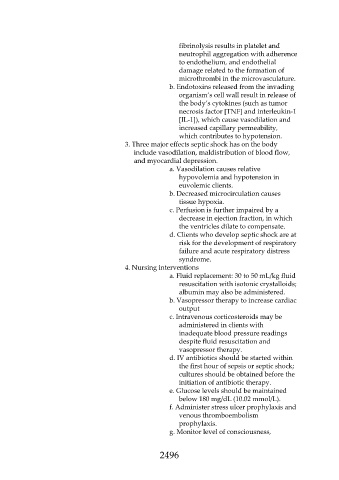Page 2496 - Saunders Comprehensive Review For NCLEX-RN
P. 2496
fibrinolysis results in platelet and
neutrophil aggregation with adherence
to endothelium, and endothelial
damage related to the formation of
microthrombi in the microvasculature.
b. Endotoxins released from the invading
organism’s cell wall result in release of
the body’s cytokines (such as tumor
necrosis factor [TNF] and interleukin-1
[IL-1]), which cause vasodilation and
increased capillary permeability,
which contributes to hypotension.
3. Three major effects septic shock has on the body
include vasodilation, maldistribution of blood flow,
and myocardial depression.
a. Vasodilation causes relative
hypovolemia and hypotension in
euvolemic clients.
b. Decreased microcirculation causes
tissue hypoxia.
c. Perfusion is further impaired by a
decrease in ejection fraction, in which
the ventricles dilate to compensate.
d. Clients who develop septic shock are at
risk for the development of respiratory
failure and acute respiratory distress
syndrome.
4. Nursing interventions
a. Fluid replacement: 30 to 50 mL/kg fluid
resuscitation with isotonic crystalloids;
albumin may also be administered.
b. Vasopressor therapy to increase cardiac
output
c. Intravenous corticosteroids may be
administered in clients with
inadequate blood pressure readings
despite fluid resuscitation and
vasopressor therapy.
d. IV antibiotics should be started within
the first hour of sepsis or septic shock;
cultures should be obtained before the
initiation of antibiotic therapy.
e. Glucose levels should be maintained
below 180 mg/dL (10.02 mmol/L).
f. Administer stress ulcer prophylaxis and
venous thromboembolism
prophylaxis.
g. Monitor level of consciousness,
2496

